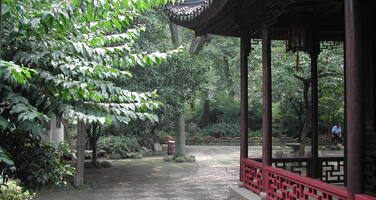Classical Gardens of Suzhou
Factors affecting the property in 2008*
- Housing
- Management systems/ management plan
Factors* affecting the property identified in previous reports
a) Urban development pressures;
b) Lack of an adequate management framework set out in a plan to address the development pressures.
International Assistance: requests for the property until 2008
Total amount approved : 0 USD
Missions to the property until 2008**
3-6 June 2004: ICOMOS monitoring mission
Conservation issues presented to the World Heritage Committee in 2008
The State Party provided to the World Heritage Centre, on 28 January 2008, a report on the developments of the Planning for the Integrated Management of the World Heritage property in Suzhou. The State Party report provides information on the updating and revision of the Master Plan for the City of Suzhou (2007–2020) and the Plan for the Protection of the Historic and Cultural City (Site management plan). Furthermore, a Special Plan for the Protection of the Classical Gardens and Cultural Heritage Properties under National Protection has been formulated.
The revised Master Plan for the City of Suzhou reiterates “the protection of the rich natural and cultural landscape of Suzhou, the tangible and intangible heritage as well as traditional landscapes of the historic and cultural city, towns and villages, and the revival and development of local culture”. It was elaborated around conservation principles and guidelines applied to the particular specificity of World Heritage status of Suzhou. The revised Master Plan is now being processed for legal review and approval by the State Council of China. According to the State Party report, the Site management plan, which embodies the basic principles of protection, will provide guidance for the protection of historic neighborhood and areas of traditional landscapes designated in the revised Master Plan.
The State Party report sets out that, according to the revised Master Plan, protection has been extended to the entire area of the ancient City of Suzhou, seven other ancient towns (four protected at national level and three at regional level), twelve ancient villages, five traditional neighborhoods, 38 historic sites, three areas of cultural landscape, and a number of cultural heritage sites. In the future, detailed plans for the protection of historic neighborhood of Pingjiang and the Humble Administrator’s Garden (Zhuzheng) will be formulated.
However, the report does not describe the contents or provide a summary of the said revised Master Plan, nor does it link to the development of a comprehensive and integrated management plan for the World Heritage property which would ensure a harmonized approach to new development and renovation, fully integrating the application of all existing heritage laws and regulatory measures, and ensure that the historic villages maintain their living character as per the request by the World Heritage Committee in its Decision 30 COM 7B.62.
Regarding the possible extension of the World Heritage property to include the entire historic town of Suzhou, and other historical canal towns within the same geo-cultural area in China, the work is in progress and a revised national Tentative List, including the extension of the Classical Gardens of Suzhou, has been submitted to the World Heritage Centre in March 2008.
The State Party report also provides information on the use of an early warning system to monitor the state of conservation of four Classical Gardens in Suzhou. This system will be introduced in 2008 to all nine gardens designated as World Heritage. Meanwhile, an information management system collecting scientific data of the four heritage gardens has been established.
Summary of the interventions
Decisions adopted by the Committee in 2008
32 COM 7B.66
Classical Gardens of Suzhou (China) (C 813 bis)
The World Heritage Committee,
1. Having examined Document WHC-08/32.COM/7B,
2. Recalling Decision 30 COM 7B.62, adopted at its 30th session (Vilnius, 2006),
3. Welcomes the progress made in the development of an updated Plan for the Protection of the Historic and Cultural City (site management plan), as requested at its 30th session (Vilnius, 2006);
4. Takes note of the State Party's intention to prepare a proposal for extension of the existing World Heritage property to include the entire historic town of Suzhou, and other historical canal towns within the same geo-cultural area in China;
5. Requests the State Party to submit to the World Heritage Centre, by 1 February 2009, the approved revised Master Plan for the City of Suzhou (2007-2020) and the Site management plan, as well as an English summary of their contents, for review by the World Heritage Centre and the Advisory Bodies.
Draft Decision: 32 COM 7B.66
The World Heritage Committee,
1. Having examined Document WHC-08/32.COM/7B,
2. Recalling Decision 30 COM 7B.62, adopted at its 30th session (Vilnius, 2006),
3. Welcomes the progress made in the development of an updated Plan for the Protection of the Historic and Cultural City (site management plan), as requested at its 30th session (Vilnius, 2006);
4. Takes note of the State Party’s intention to prepare a proposal for extension of the existing World Heritage property to include the entire historic town of Suzhou, and other historical canal towns within the same geo-cultural area in China;
5. Requests the State Party to submit to the World Heritage Centre, by 1 February 2009, the approved revised Master Plan for the City of Suzhou (2007–2020) and the Site management plan, as well as an English summary of their contents, for review by the World Heritage Centre and the Advisory Bodies.
Exports
* :
The threats indicated are listed in alphabetical order; their order does not constitute a classification according to the importance of their impact on the property.
Furthermore, they are presented irrespective of the type of threat faced by the property, i.e. with specific and proven imminent danger (“ascertained danger”) or with threats which could have deleterious effects on the property’s Outstanding Universal Value (“potential danger”).
** : All mission reports are not always available electronically.


